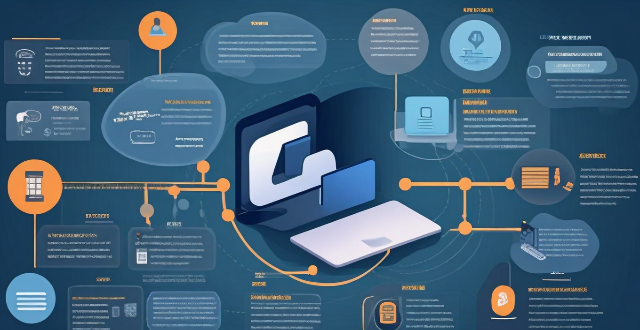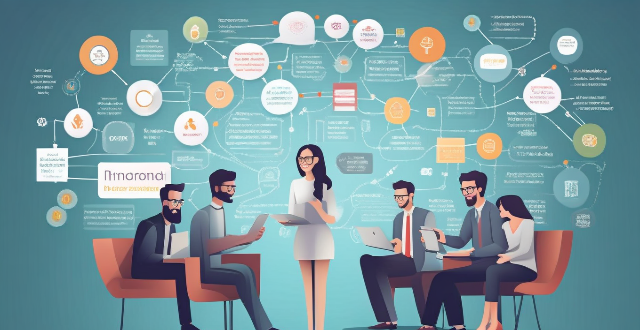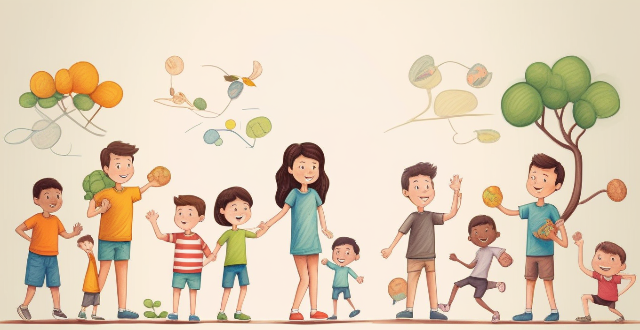Social Article

How does social media impact the development of teenagers ?
The article discusses the impact of social media on teenagers, highlighting both its positive and negative effects. The positive effects include connectivity, information and learning, and creativity and self-expression. However, the negative effects such as addiction, cyberbullying, and privacy risks are also significant concerns. The article emphasizes the need for responsible and safe use of social media by teenagers.

What are the social implications of environmental degradation ?
The article discusses the social implications of environmental degradation, including health impacts such as air pollution and water pollution, economic impacts such as loss of biodiversity and job losses, social impacts such as displacement and cultural loss, and political impacts such as conflicts and refugees. It emphasizes the need for collective action to address these challenges and protect the natural environment for future generations.

What are the psychological effects of social media on teenagers ?
This article discusses the psychological effects of social media on teenagers, including increased anxiety and depression due to comparison with others' lives, fear of missing out (FOMO), cyberbullying, disrupted sleep patterns, decreased face-to-face interaction, body image issues, and cyberchondria. Parents and educators should monitor their children's social media usage and encourage healthy habits to help them navigate these challenges.

How does social harmony impact economic development and stability ?
Social harmony is essential for economic development and stability, as it increases productivity, reduces conflict, improves governance, attracts foreign investment, and enhances social cohesion.

How do data protection regulations apply to social media platforms ?
This article discusses the crucial role of data protection regulations in safeguarding user information on social media platforms. It outlines key principles such as transparency, purpose limitation, and accountability that guide the handling of personal data by these platforms. The responsibilities of both social media platforms and users are highlighted, emphasizing the importance of informed consent, security measures, and user control. The article concludes by stressing the mutual responsibility of platforms and users in promoting a safe online environment through adherence to data protection regulations.

What is the role of social media in sports marketing ?
The article explores the role of social media in sports marketing, highlighting its ability to engage with fans, promote events, and build brand awareness. It suggests that by producing high-quality content and engaging with followers, sports organizations can increase their online presence and attract new fans. The article also discusses strategies for promoting events on social media, such as targeted advertising and word-of-mouth marketing. Overall, it emphasizes the importance of social media in modern sports marketing and encourages teams to leverage these platforms to reach their target audience.

What are the potential risks that climate change poses to child safety ?
The article discusses the potential risks that climate change poses to child safety, including direct physical threats such as extreme weather events and natural disasters, as well as indirect impacts on health and social stability. These risks include food and water scarcity, air quality issues, mental health problems, and social disruption. The article emphasizes the importance of taking action to mitigate the effects of climate change and protect children's well-being.

What role does social media play in product review dissemination ?
The article discusses the significant role of social media in product review dissemination. It highlights the concept of "social proof" where people trust and adopt a product seeing others using it and sharing positive reviews. Social media platforms provide a platform for users to share their experiences with products, both good and bad, which can greatly influence potential customers' purchasing decisions. User-generated content (UGC) is a powerful tool for brands looking to promote their products. By encouraging customers to share their experiences with a product on social media, brands can leverage the power of social proof to attract new customers. Influencer marketing is another way that social media affects product review dissemination. Brands partner with influencers who have large followings on social media platforms to promote their products. Online reviews have become an essential part of the purchasing process for many consumers. Social media platforms provide a space for users to share their thoughts and opinions about products, allowing potential customers to make informed decisions before making a purchase. The trustworthiness, variety of opinions, and timeliness of online reviews greatly impact a consumer's decision to purchase a product or not. In conclusion, social media plays a crucial role in product review dissemination by providing a platform for users to share their experiences with products, promoting user-generated content and influencer marketing, and facilitating the sharing of online reviews.

How does educational equity relate to social justice ?
Educational equity and social justice are interconnected concepts that aim to create a fair and just society. Educational equity involves providing equal opportunities for learning and addressing disparities in resources, funding, and support services between schools or communities. Social justice encompasses policies and practices that ensure everyone has equal rights, opportunities, and access to resources while eliminating discrimination based on various factors. The relationship between educational equity and social justice includes addressing systemic inequalities within the education system, providing access to quality education for all students, promoting diversity and inclusion, and empowering students to become agents of change in their communities. By achieving educational equity, we can work towards creating a more just and equitable society.

How does one's personal hygiene affect their social interactions ?
Personal hygiene is crucial for positive social interactions, boosting confidence, and maintaining good health. Good hygiene habits include regular bathing, teeth brushing, wearing clean clothes, hand washing, and taking care of skin and hair. Poor hygiene can lead to social isolation, misunderstandings, and health risks. Following simple tips can ensure that personal hygiene positively impacts social interactions.

How do social media platforms contribute to the proliferation of celebrity romance speculation ?
The article discusses the role of social media in celebrity romance speculation, highlighting various aspects such as fan engagement, media strategies, and the nature of online content sharing. Fans create hashtags and ship names to root for their favorite celebrities, while media outlets promote stories about relationships to increase click rates. Celebrities or their teams sometimes post ambiguous photos or messages on social media, which fans interpret as hints about romantic involvements. The immediacy of social media means that any small interaction can be blown out of proportion before there's an opportunity for clarification, and fans often congregate in echo chambers where speculation is amplified. The article concludes that the proliferation of celebrity romance speculation on social media is a complex interplay between fan enthusiasm, media strategies, and the inherent traits of online platforms.

What are the best practices for social media advertising ?
Best practices for social media advertising include defining goals, understanding the audience, choosing the right platform, creating compelling content, optimizing for mobile devices, testing and refining ads, monitoring budget, leveraging social proof, and staying up-to-date with platform changes. These strategies help achieve better results in terms of engagement, lead generation, and sales.

What impact does sports have on the social cohesion and community spirit in rural areas ?
The article discusses the impact of sports on social cohesion and community spirit in rural areas. Sports bring people together, promote teamwork, and create a sense of belonging that can strengthen the fabric of a community. The article explores how sports build social capital by forming friendships and encouraging civic engagement. It also highlights how sports promote teamwork and cooperation by teaching communication skills and collaboration towards a common goal. Finally, the article emphasizes how sports create a sense of belonging within a community by supporting local teams and participating in community events. Overall, sports have a significant impact on rural communities and contribute to their overall well-being.

What are the pros and cons of using social media in education ?
The article discusses the advantages and disadvantages of using social media in education. Advantages include enhanced communication, collaboration and networking, access to diverse information, skill development, and flexible learning. Disadvantages are distractions and time management, privacy concerns, misinformation, academic integrity issues, equity concerns, and teaching challenges. The conclusion states that careful consideration and strategic implementation are key to harnessing the benefits of social media in education while minimizing its drawbacks.

How does exercise influence social skills in children ?
Exercise plays a crucial role in shaping children's social skills by enhancing communication, empathy, emotional intelligence, resilience, problem-solving abilities, healthy risk-taking, and leadership skills. Physical activity helps children build self-confidence, promotes teamwork, develops empathy, enhances emotional intelligence, increases resilience, enhances problem-solving abilities, encourages healthy risk-taking, and fosters leadership skills. These skills are essential for establishing positive relationships with peers and contributing to their communities. Therefore, it is imperative to encourage children to engage in regular exercise to support their overall development and success in life.

Are there any specific exercise programs designed for seniors that focus on building social connections ?
The article discusses the benefits of exercise programs for seniors that focus on building social connections. It highlights how regular exercise can improve physical health, mental health, and increase social connections in seniors. Examples of such programs include SilverSneakers, Tai Chi, walking groups, yoga, and water aerobics. The article emphasizes the importance of staying active and connected within communities as we age.

Can social media platforms be used to enhance social harmony ?
Can social media platforms be used to enhance social harmony? The text discusses the positive impact of social media on social harmony, including connectivity and communication, sharing information and ideas, and civic engagement and activism. However, it also highlights challenges and risks such as misinformation and fake news, online harassment and cyberbullying, and echo chambers and polarization. The conclusion states that social media platforms have the potential to enhance social harmony, but challenges must be addressed to ensure their positive impact.

What is the relationship between cultural fusion and social acceptance ?
The text discusses the interplay between cultural fusion and social acceptance, two significant phenomena that shape modern societies. Cultural fusion is defined as the process where different cultures interact, leading to new cultural forms, while social acceptance refers to the degree of support for diversity within a society. The text outlines key points for each concept: diversity, innovation, and interconnectedness for cultural fusion; tolerance, empathy, and equality for social acceptance. It then explores their interaction, suggesting that cultural fusion can promote social acceptance by increasing exposure to different cultures, breaking down stereotypes, and promoting tolerance. Conversely, high levels of social acceptance can foster further cultural exchange and innovation. The conclusion emphasizes the cyclical relationship between the two concepts and their importance in building harmonious societies that embrace diversity and change.

What are the latest trends in social media marketing ?
Social media marketing trends businesses should consider include personalization, video marketing, influencer marketing, social listening, and shoppable posts. Personalization helps brands connect with their audience on a more personal level, while video marketing allows for visually engaging content that can lead to higher engagement rates. Influencer marketing enables businesses to reach new audiences and build trust, while social listening provides insights into consumer sentiment and identifies opportunities for improvement. Shoppable posts streamline the purchasing process and increase conversion rates.

What is the impact of social media on women's mental well-being ?
Social media has become an integral part of our daily lives, and it has both positive and negative impacts on women's mental well-being. In this article, we will discuss the various ways in which social media affects women's mental health. ### Negative Impacts: #### 1. **Comparison and Jealousy** One of the most significant negative impacts of social media on women's mental well-being is the constant comparison and jealousy that arises from seeing other people's highlight reels. Women often compare themselves to others on social media, leading to feelings of inadequacy and low self-esteem. This can result in anxiety, depression, and even eating disorders. #### 2. **Cyberbullying and Harassment** Social media platforms are also notorious for cyberbullying and harassment, particularly towards women. Online harassment can take many forms, including trolling, stalking, sexual harassment, and doxxing. These actions can have severe consequences on a woman's mental health, leading to trauma, anxiety, and depression. #### 3. **Addiction and Time Management** Social media addiction is another issue that affects women's mental well-being. Spending excessive time on social media can lead to procrastination, reduced productivity, and poor time management skills. This can cause stress, anxiety, and feelings of guilt, ultimately affecting a woman's overall mental health. #### 4. **Body Image Issues** Social media is flooded with images of perfect bodies and beauty standards, which can negatively impact a woman's body image. Constant exposure to these unrealistic beauty standards can lead to body dysmorphia, eating disorders, and low self-esteem. ### Positive Impacts: Despite the negative impacts, social media also has some positive effects on women's mental well-being. #### 1. **Support and Community** Social media provides a platform for women to connect with like-minded individuals and form supportive communities. These online communities can offer emotional support, advice, and encouragement, helping women cope with various issues they face in their personal and professional lives. #### 2. **Education and Awareness** Social media is an excellent source of information and education on various topics related to women's health, such as menstrual hygiene, reproductive rights, and breast cancer awareness. This increased awareness can empower women to make informed decisions about their health and well-being. #### 3. **Self-expression and Creativity** Social media platforms provide women with an opportunity to express themselves creatively through writing, photography, art, or other forms of content creation. This creative outlet can serve as a therapeutic tool for women to cope with stress, anxiety, or depression. #### 4. **Career Opportunities** Social media has opened up numerous career opportunities for women in fields such as digital marketing, content creation, and influencer marketing. These opportunities allow women to pursue their passions while maintaining flexible work schedules that accommodate their personal lives. In conclusion, social media has both positive and negative impacts on women's mental well-being. While it can lead to comparison, jealousy, cyberbullying, addiction, and body image issues, it also provides support, education, self-expression, and career opportunities. It is essential for women to be aware of these impacts and use social media mindfully to maintain their mental health and well-being.

Can social distancing be implemented in schools and universities effectively ?
Social distancing is crucial to prevent the spread of infectious diseases, but implementing it in educational institutions like schools and universities can be challenging. Challenges include limited classroom space, managing student interaction outside of the classroom, and ensuring staff training and compliance. Effective strategies for implementing social distancing in these environments include classroom redesign, virtual learning options, signage and reminders, and monitoring and enforcement. By prioritizing health and safety, educational institutions can contribute to controlling the spread of infectious diseases while continuing to provide quality education.

What impact has social media had on the way we consume and interact with sports content ?
In this article, we have explored the impact of social media on sports content consumption and interaction. We discussed how social media has revolutionized the way fans engage with sports content by providing live updates, facilitating fan discussions, enabling personalized content and customization, and making sports content more accessible and mobile. Overall, social media has transformed the sports ecosystem and will continue to shape the future of sports content consumption and interaction.

Can I control who sees my personal information on social media platforms ?
The article discusses how individuals can control who sees their personal information on social media platforms. It provides tips such as reviewing privacy settings, using lists and groups, being mindful of tagging and mentions, protecting personal information, and regularly reviewing privacy settings. By following these guidelines, users can customize their profile visibility and manage access to their personal information on social media platforms.

How does regular exercise impact the social well-being of seniors living alone ?
Regular exercise is crucial for enhancing the social well-being of seniors living alone, as it improves mood and mental health, increases social interaction, enhances cognitive function, and reduces the risk of chronic diseases. Engaging in regular exercise can help seniors maintain their independence and improve their overall quality of life.

Is social media addiction a real problem, and how can it be addressed ?
Social media addiction is a growing problem with significant impacts on mental health, relationships, and productivity. Recognizing the signs of addiction, such as excessive use or neglecting important activities, is crucial for addressing the issue. The negative effects include mental health issues, relationship problems, and reduced productivity. To combat social media addiction, individuals can set limits on usage, find alternative activities, practice mindfulness, and seek professional help if needed.

What are the social consequences of natural disasters caused by climate change ?
Natural disasters, intensified by climate change, have extensive social repercussions affecting health, economy, social order, education, and the environment. Immediate impacts include physical harm and mental distress, while long-term effects range from economic setbacks to environmental degradation. Addressing these consequences necessitates a multifaceted strategy encompassing emergency measures, recovery efforts, and sustainable development practices to foster community resilience.

How do celebrities balance their personal and professional lives on social media ?
Balancing personal and professional lives on social media can be challenging for celebrities. Clear boundaries, separating personal and professional accounts, scheduling posts wisely, engaging with followers appropriately, and seeking professional help when needed are effective strategies for maintaining this balance. By following these strategies, celebrities can maintain a healthy balance between their personal and professional lives on social media while still connecting with their fans in meaningful ways.

Can sports be used as a tool for social change and community development ?
This text discusses the potential of sports as a tool for social change and community development. It highlights how sports can break down barriers, promote health and well-being, and contribute to education and personal development. The article also explores how sports can address social issues, empower communities economically, and promote peace and reconciliation. However, it emphasizes the need for equitable resource allocation, accessibility, and sustainability to fully realize the potential of sports in societal transformation.

Can you provide examples of female-driven social enterprises that combine business with philanthropy ?
Female-driven social enterprises are combining business with philanthropy to create positive change in society, empowering marginalized individuals and promoting sustainability. Examples include Samasource, Prodigy Finance, Kiva, S'well, and Girlfriend Collective. These organizations demonstrate the power of women in driving social impact through sustainable business practices.

What role does social media play in the promotion of sports and fitness ?
Social media plays a significant role in promoting sports and fitness by connecting people with similar interests, providing access to information and resources, enhancing brand awareness and marketing efforts, facilitating fundraising and charitable events, and encouraging healthy lifestyle choices. It has become an essential tool for creating communities around various sports and fitness activities, allowing individuals to find like-minded individuals, form communities, and share their experiences, knowledge, and achievements. Social media also offers a vast amount of information and resources related to sports and fitness, making it possible for individuals to learn about new techniques, training methods, and health tips without leaving their homes. Additionally, social media platforms often feature live streams of sporting events, allowing fans to watch their favorite teams and athletes compete in real-time. In conclusion, social media is an effective tool for promoting sports and fitness, and its impact will continue to grow as technology evolves.